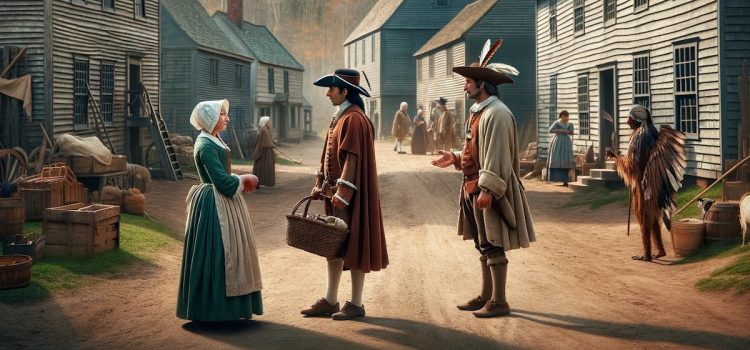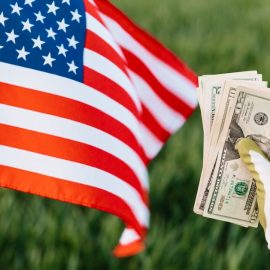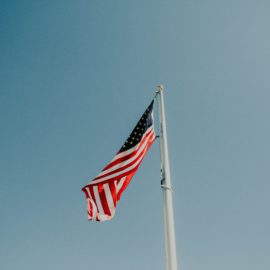
What drive European colonists to the Americas? What role did slaves, American Indians, poor people, and women play within the social system?
Historian Howard Zinn begins his book A People’s History of the United States with a brief overview of the history of colonial America. He outlines why this colonial project started, how it functioned, and the circumstances that eventually changed a group of colonies into the US.
Keep reading for a summary of Zinn’s nontraditional history of the colonial era in America.
America’s Colonial Era (1492-1788)
Zinn contends that colonialism was the result of the development of capitalism—an economic system in which people compete to accumulate as much private property as possible—in Europe. Under this new system, individuals and nations constantly sought new sources of wealth. This search eventually led European colonists to the Americas: resource-rich continents full of cultures and peoples without the military technology or cutthroat competitive economic systems of Europe.
Zinn begins his history of colonial America with Christopher Columbus in 1492. European colonists engaged in a pattern of conquest, genocide, and enslavement of Indigenous peoples throughout the Americas with the goal of getting rich. Not all colonists were vicious all of the time, but exploitation and bloodshed were the driving force during this period of history.
(Shortform note: While Zinn presents colonialism as a product of capitalist greed, some scholars argue that colonial exploitation contradicts key principles of capitalism: namely, competitive enterprise and voluntary exchange. Essentially, capitalism promotes competition and mutual, voluntary exchanges of goods and services. By contrast, colonialism was marked by force and exploitation, yielding a one-sided outcome that only benefited Europeans. Thus, some scholars argue colonialism was actually driven by mercantilism—an economic system of restricting imports and encouraging exports to maximize profits from trade. Colonialism allowed mercantilist nations to extract more resources to export and open more markets to sell exports in.)
The Classes of Colonial America
Through the 17th and 18th centuries, British elites established a number of colonies in North America. These colonies functioned according to a hierarchical class system with wealthy white men on top:
- Financiers, aristocrats, and merchants in Britain invested in—and extracted as much resource wealth as possible from—the colonies.
- Elites in the colonies themselves managed the harvest and sale of resources, owning a majority of colonial farmland and manufacturing facilities.
- A middle class of skilled laborers and small landholders made less than elites, but enough to live independently.
- Poor white laborers and farmers worked directly for American elites, while slaves and American Indians had few or no rights or property.
Zinn discusses the experience of the people within this system’s lower class and how they tried to improve their circumstances:
Slaves: Displaced and Exploited
Enslaved Africans (and in future generations, African-Americans) provided a large force of free labor that was crucial for the early survival and profitability of the American colonies, explains Zinn. He argues that while ideas of white racial superiority and racism existed before the slave trade, they became widespread and dominant because of it.
Slavery existed in Africa before Europeans arrived, but on a smaller scale and under less brutal conditions. Under capitalism, though, slavery became a massive and horrific industry. Slaves were kidnapped (usually in West Africa), separated from their cultures and communities, then shipped in horrible conditions to be exploited for the rest of their lives. They had no rights and no property; white colonists often tortured, raped, and killed them with no repercussions.
Elites promoted white supremacy and racism to justify the slave trade and to sow division between poor whites and Black slaves—they feared that these two groups working together could overthrow the colonial class system. This nearly happened in 1676, Zinn notes, when English colonist Nathaniel Bacon united poor whites and Black slaves to revolt against the colonial government. After quelling the rebellion, colonial elites passed a number of “slave codes” formalizing race-based segregation to prevent a similar event from happening again. Without the option of revolt, some enslaved people resisted oppression through working slowly, sabotaging the workplace, suicide, murdering slave owners, or running away.
Poor Whites: Trying to Get By
Poor white European colonists served two main purposes for elites in the colonial class system:
1) Laborers: Instead of owning property, many poor whites worked for elites. Their work took several forms: Some were indentured servants, working for a set number of years to regain their freedom. Others worked as tenant farmers, renting land from elites to farm. Still others worked for wages in elites’ factories. Regardless of what they did, all laborers worked under unpleasant conditions—enduring abuse, low pay, and little economic mobility.
2) Frontiersmen: Some poor whites went west to the frontier, fighting American Indians for their land to escape poverty. This served as a form of social control by elites—it allowed poor whites to act as a “buffer” between the Indians and the elites, while also ensuring poor whites on the frontier saw Indians, not the exploitative elites, as the main obstacle to financial security.
Women: Kept Separate and Below
Zinn argues that because European society was based on accumulating private property, there were economic incentives for men to treat women as unpaid servants and childbearers—especially since more children meant more available labor. As a result, women in the colonial era were kept from political and economic capital regardless of their class position.
Women were kept in the household, unable to own property, collectively organize with other women to demand fairer treatment, or exercise control over their lives or legal rights. Rape and other forms of abuse were common, and usually went unpunished—especially when enslaved or American Indian women were the victims. Despite this, women still fought for equality; middle- and upper-class women argued and wrote on behalf of women’s rights, while poor women in factories organized walkouts and strikes for better working conditions.
The American Revolution (1765-1783)
While the colonial class system successfully repressed lower-class revolt, it didn’t stop elites from competing with one another. As such, Zinn argues that the American Revolution was a conflict between British and American elites, not a popular uprising. In the years leading up to the war, American elites had two significant problems:
- Increased British taxes and tariffs were cutting into their profits.
- Class tension was growing among poor whites throughout the mid-18th century over horrible living and working conditions and low pay. Isolated revolts, riots, and rebellions became common: tenant farmers collectively refusing to pay rent, angry mobs storming stores and warehouses for food, and so on.
The American Revolution allowed American elites to address both of these problems: They recruited poor whites to fight the British instead of resisting the colonial class system. While many middle class and elite Americans believed in the ideals of the revolution—such as popular government and universal rights—they ultimately fought for their own benefit, not for any major redistribution of power or wealth between classes. The other classes were ambivalent about the war.






